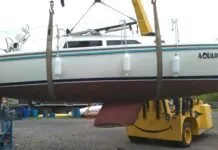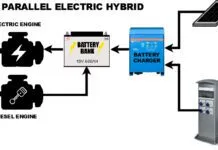Although I spent most of my cruising years within 20 degrees of the equator, the landlubber luxury I missed most was not air conditioning (I’m a warm-blooded type), but a hot water shower.
We used a solar heated “sun shower” for most of our bathing needs. On a sunny day, the 1-gallon flexible plastic bag with one transparent side would deliver water that was plenty hot, but the drizzle of water usually left me unsatisfied. Friends used a manually pressurized garden sprayer which they had painted black. This added a bit more pressure, but like the collapsible foot-pump pressurized Helio shower we tested back in 2016, it was most effective in sunny warm climates. (Chapin now makes a black polyethylene industrial sprayer, in addition to their translucent garden sprayers.)
As I go about with the refit of Opal, the 1971 Yankee 30, my biggest challenge is deciding which of the comforts I missed during my life aboard Tosca I’d like to add. A below-decks hot water shower would be nice. Since a Lake Superior cruise is high on my bucket list and having spent the last two so-called “summers” in Marquette, MI, I’m pretty sure I won’t get the same performance out of my sun shower as we did in Fiji.
What about a tankless propane heater? You will see these on boats, but as we’ve found in the past, the propane systems are generally not safe on boats. The folks at Seaworthy published a safety alert regarding on-demand water propane water heaters a few years back which spells out the problems with these systems. Because of the associated risk, they are not compliant with the American Boat and Yacht Council‘s standard. Although I think this risk could be manageable, it could invite insurance claim squabbles if there’s a fire, and I’m trying to reduce or eliminate my reliance on carbon-based fuels.
Since we last looked at boat heating options, advances in renewable energy and energy storage coupled with the explosion of interest in off-the-grid living has led to a variety of other options for moving heat where you need it. For those with a surplus of power (and bigger wallets). Two of the bigger names in marine heating, Webasto and Eberspaecher offer some dual water-air heaters with good reputations in the marine world. But when you include all that is required, these systems can be expensive.
If a “marine” 12-volt water heater like the ones we tested is out of reach, there are some less expensive 12-volt options aimed at RVers. Computer nerds will no doubt enjoy the Everlander’s YouTube video on building their solar powered water heater, using a converted Rheem water tank. (Note that they have a massive rooftop solar array, pushing the limit for space on most monohulls.) I noticed that Bouge RV a company catering to the “van-life” crowd with 12-volt appliances recently introduced a portable hot water heater using propane cannisters. As a side note, I’ve been using a portable freezer-fridge from Bouge RV for 16 months without a hiccup. It’s not the most efficient system — but having freezer fridge that can move from boat to car in snap has changed the way I travel. (No more ice!)
Currently, I’m leaning toward one of the marine water heaters that Practical Sailor has tested in the past. My next step will be figuring out where to fit it. Here is tester and marine surveyor Frank Lanier‘s assessments of the installation process:
The physical installation of a water heater may seem pretty straightforward, but the devil is indeed in the details. It starts prior to purchase, with a search for adequate space that’s relatively near the engine and vertically as low as possible. Next is bonding in a well-reinforced surface to mount the water heater onto. The empty tanks are relatively light, but if you add 45 to 88 pounds of water, you can see why a sound support base is important in a rough seaway.
Plumbing can be a bit of a challenge, especially when it comes to trapping air bubbles that will cause the engine’s coolant pump to cavitate. Every diesel engine circulates coolant with a vane-type pump, and though its long-term reliability is legendary, this type of pump is not a positive-displacement pump. That means it is not self-bleeding, so if air bubbles are not bled from the system, the pump ingests the air and spins little or no circulating water. This is one of the reasons why remote surge or top-off tanks for coolant are always placed higher than the engine itself. It’s also why there’s also a butterfly bleed valve on the top of heat exchangers.
In situations where the heat exchanger in a water heater has an inverted U-shape, with the inlet and outlet lower than the high point in the loop, care must be taken to rid the coolant circuit of all air bubbles when refilling with water and antifreeze. Air always seeks the high point, and this is another reason why some manufacturers say that their water heaters should be mounted at or below engine level, nearly impossible on many sailboats.
Globalization has made plumbing more difficult, and unless you have a good source for metric bronze pipe fitting, it’s vital to purchase metric-to-NPT conversion couplings (usually available from heater vendors).
To keep pipe joints from leaking, use Teflon tape or pipe joint compound and remember that hose barb-to-hose connections are much easier to make drip-proof with a hose clamp than the same connection made on a threaded pipe stub. (See our test of tapes and thread sealants in the November 2021 issue.) Care also needs to be taken when connecting stainless-to-stainless joints, in order to avoid galling the threads. Many European marine plumbing manufacturers have switched to high-quality, investment-cast stainless steel. Nevertheless, these fittings are not as malleable or corrosion resistant as silicone bronze, so be sure to not over-tighten or allow stray DC current to run through these fittings.
If you are shopping for a water heater, our in-depth report on water heaters is a good place to start. I’d love to hear about readers’ experiences with hot water systems. You can add them in the comments below, or send to me [email protected].









































Ralph’s point about clearing the air from the hot water heater’s plumbing pertains to the location of our SS heater tank on a Mason 43, which is a couple of feet above the engine. On these boats the engine is located under the cabin sole, an area that is already crowded with no room to add an insulated 11 gallon tank. We solved the problem about twenty-five years ago by adding a 12 volt pump into the run from the engine to the higher water tank. The small pump is low enough that it does not become air bound and a few minutes of running it clears air from the system. We then shut it off, throw two small ball valves to by pass it, and are good until we next lay the boat up for the Winter.
Ralph is a sailor’s sailor with a great fund of knowledge. He kindly moderated several of the Safety At Sea Seminars that my wife and I coordinated for the Cruising Club of America before Bermuda races. These had upwards of three hundred attendees and were a challenge for anyone to moderate well.
To be clear, engines do not have vane type water pumps.
Vane pumps are positive displacement pumps used in hydraulic systems.
So, is it incorrect to refer to those little radial legs on a rubber impeller as vanes?
Ok will share some insight from licensed marine engineer from the VLCC/LNGC industry at a high level, but also have an old classic boat with a 40hp westerbeak
1. You are both correct, vanes exist on some hydraulic pumps, rubber impeller pumps, and also the divisions on an open or closed type impeller for a centrifugal pump, are called vanes..
2. A Positive displacement pump moves a specific volume of fluid for each full shaft rotation. Flow rate is proportional to shaft rpm. Many hydraulic pumps are vane type, with metal vanes the slide in and out of the center, within a non concentric casing, similar to the impeller on your raw water pump, only that those rubber vanes fold back in the non concentric casing, the next vane pushes the water out of the discharge port, as the space holding that pocket of water between the vanes is made smaller by the casing shape. (large ship ram type steering gears, have variable displacement hydraulic rotary piston pumps, with a tilting plate, to control the follow of oil to the system, so at constant rpm, the tilting plate controls the stroke of the pistons, and thus variable displacement -0-100% flow at constant rpm) Other hydraulic systems depending on size/design/service/fluid properties can use , gear pumps, vane pumps and screw pumps, ete. Larger systems may have regulating valves on the discharge, but always a relief valve to protect damaging the pump. Small raw water pumps, typically dont, and vanes are flexible, but operating with a blocked discharge on these will will result in damage to vanes over a short period of time, over heating, and eventual failure. (blockage on other types of pos dspl pumps will destroy pump, shear coupling, ete. Note the typical rubber impeller raw water pump moves water thought the raw water /fresh water heatexchanger and then overboard, likely via your exhaust system
2. There is a second pump that circulates the engine coolant fresh water, through the engine passages, lube oil cooler and the same heatexchanger that has raw water flowing through it(in separate passages), that is typically centrifugal, and is typically belt driven but can also be engine driven, and on big ships will be electric driven in most cases. Centrifugal pumps have very different properties than positive displacement, advantages disadvantages, but are typical for circulation of engine fresh water coolant for a number of reasons. The article above does not make clear some specific system/pump properties that is perhaps leading to some confusion a hot water loop for heading your potable water, which is engine engine coolant very typically driven by the fresh water coolant centrifugal pump on your engine.
3. Your lube oil pump, is typically a engine driven gear pump. (large ship main engines have 2 ea electric driven screw pumps)
4. you also have a fuel pump, and on non-common rail designs (newer environment tier III compliant) that is typically a variable positive displacement pump, with a rack that rotates the piston, which has passages machined into it to deliver a variable amount of fuel based on relative position of piston to cylinder liner ports (also called a jerk pump)
5. Centrifugal pumps can get air bound in the casing,(hence referance to head tank over pump in article) have limited suction lift capabilities if not primed, ete, where positive displacement are typically self priming. (but yes you can have air issues in your fuel system too…)
Hope this helps! Sailboat sailor and past Dual License officer on merchant ships, remember it can be very hard for them to see you, even though you see them, my first cadet ship was over 1’000 long, coming out of English Channel in the TSS, very hard to pick up sailboats in white caps during the day, white sail/white hull/dark hull, I was shocked, as an experienced offshore sailor before my professional education at the Academy. So be proactive and assume they cant see you even with Class B AIS. All the best, sorry for any inacuracies above, was trying to be as general as possible, but may not be specific yours installation. time to check on the turkey:)
So Ralph, is there any way to provide hot water on a raw water cooled boat while underway other than heating some in a tea/coffee pot on the stove? I’m thinking of sailing to the Falklands in/on my Catalina 27 and then east around in the “Roaring Forties.” HaHa. Insincerely, Gale Carlson.
I had a raw water cooled motor on my Jenneau. I plumbed in a bypass from the raw water exhaust thru the water heater and back to the exhaust. The bypass had ball valves to that were opened when I wanted to heat water in the tank. It took about 3o minutes to heat the water in the 10 gallon tank. Those valves were then closed so that exhaust water did not flow thru thw water heater.
If the raw water leaving the running engine is warm to hot you can use insulated tubing to detour through a 4 gallon water heater’s hot water coil before entering the water lift muffler.
Hot water heater is best if equipped with a thermostatic mixing valve on its hot water supply.
Knarly sailors hold a bucket under the exhaust to get hot water for the dishes. A little oil on the pan keeps it from rusting don’t you know, and keeps you regular.
Hi Guys, tpo nstay on the subject of HW spefically, the tank. Yup ties that sucker down. Our boat was a Beneteau 440 with a classic and highly successful installation. But to be failsafe, I installed two through hull type valves in both the raw water (coolant copper piping feeds to be able to isolate the HWT from the coolant source. That would negate loss of coolant if the HWT heat exchanger failed. Also, at Raritan’s suggestion, I changed the in-tank anode every couple of years. Never had a problem
The author of this article seems to have no plumbing experience at all nor even discussed how to fit piping nor dealing with air in recirculating lines. These are issues dealt with by domestic plumbers every day. So here’s some insight. First hardly anyone does threaded pipe or even soldered copper anymore. It’s all done with flexible PEX tubing. Look it up. Second, air is removed from lines by installing automatic bleaders in a high point in the line and not by limiting installation of the water heater above the heat source. Oh bye the way, make sure you install a pressure temp relief valve in the hot water tank. Without one you could have a real surprise 😂
Pex type plumbing is inappropriate in this application as we are talking about engine coolant, ethylene glycol at temperatures approaching 200f. Self bleederd also not acceptable in the engine coolant loop. Pex, Whale, SeaTech are all acceptable on the potable water side of the system.
An alternative for raw water or fresh water cooled engines is diesel hot water on demand heaters from companies like Espar. They are popular with European builders. I have limited experience personally, I am sure the have there own pros and cons.
I have a Webasto diesel fueled water heater that is about 6″ cubed. I use that to heat and keep hot about 3 gallons of antifreeze solution. From there I use that working fluid in a loop to circulate the fluid to three ~8″ cubed air handlers to heat my various cabins. For domestic hot water the same fluid goes through a flat-plate liquid to liquid heat exchanger. I have a similar hot water loop that I recirculate shower water so I can take my usual 20 minute hot shower using only about a gallon of fresh water. The gallon of shower water is discarded after the shower and a final rinse in clean water is available if one so desires. Details can be seen at http://prestissimo.org/plumb_heating_system.htm
On my boat, i only heat the cold water; if i had the hot water, I would not need a heater (;-). Therefor, I installed a water heater (as opposed to hot water heater).
The best marine water heater is an investment with a load of benefits. Hot water is a necessity but it can be luxurious when I’m cruising with my boat. It can make a huge difference in my sailing experience due to the immense comfort that it brings.
I installed a Quick 20 litre HWH this spring, replacing a very tired, poorly insulated creature that I was not sure if original on my1981 Baltic 42 DP. I had to replace a platform right above the engine to support the HWH and while I was at it completely redid the sound proofing/insulation in the entire engine compartment. Plumbing was a cake walk. The Quick HWH holds hot water for almost 24 hours. It is easy to drain and winterize. The bracket that keeps the HWH in place is easy to adjust and holds! I have cruised Lake Superior for 25 years and used Sun Showers for many of them. My wife and I still keep a Sun Shower full while cruising but seldom need to tap into it.
Ted Smith
Duluth, MN